
Switzerland - BVB Basel Verkehrsbetriebe, City of Basel trams & buses
For a full scale picture, please click on the picture shown !
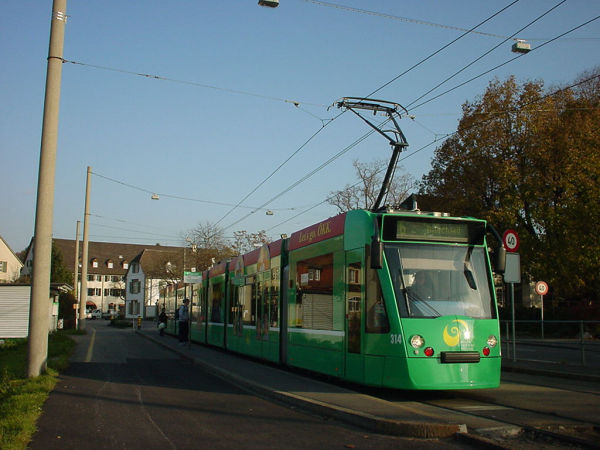
BVB - or B.St.B. as it was in 1895 when it was founded - is the company of the "green" trams of the city of Basel, owned by the
City of Basel. Basel is a peculiar city with two tram companies operating on the same tracks. The "city" trams of BVB are green
and the Baselland BLT trams, which operate a couple of longer lines from the city out into Kanton Baselland are yellow and red.
BVB has a lot of traditions and it used to have a network which reached far into the neighbouring country of Germany still at the
time of Hitler´s "Third Reich": the BVB network reached from Basel both the city of Lörrach in Baden-Württemberg and also St. Ludwig
(nowadays St.Louis) in Elsass, now Alsace, France, as well as over the so called BUeB, Basler Überlandsbahn over to almost Liestal, today´s
capital of Kanton Baselland.
Today Basel is a mid-sized town with a highly developed tramway system. Car traffic in the old city has been made almost impossible,
with a deliberately strange traffic policy which tries to push people to use public transport. Car parking is all but
hopeless, but at least the writer has never seen such an extensive and efficient tram network in such a small town as Basel before.
And during the last decades the Basel trams have yet again extended outside the borders of Basel and Switzerland. Line 8 leads to Weil am Rhein
in the German Bundesland Baden-Württemberg and line 3 has been extended to St Louis in Alsace, now France, previously Germany.
In the beginning of the new century the city of Basel got for the first trams since a long time. These were Siemens' Combino
trams of a completely new generation. Here is one of the Combinos when it was still quite new. But it wasn't a well thought design.
Most of the heavy equipment was placed on the roof of this totally low-floor tram, but the chassis was built from aluminium and other lightweight
materials. It soon turned out that if there would be a serious accident, people sitting in the tram could risk getting all the heavy equipment
dropping from the roof right on top of them. Siemens had to renovate each tram and it took a lot of time. It also meant for BVB that for a long
period some of the new trams were out of use, so a shortage of trams resulted.
Picture of a new Combino tram in the village of Riehen in Basel 21.12.2001 by Ilkka Siissalo.
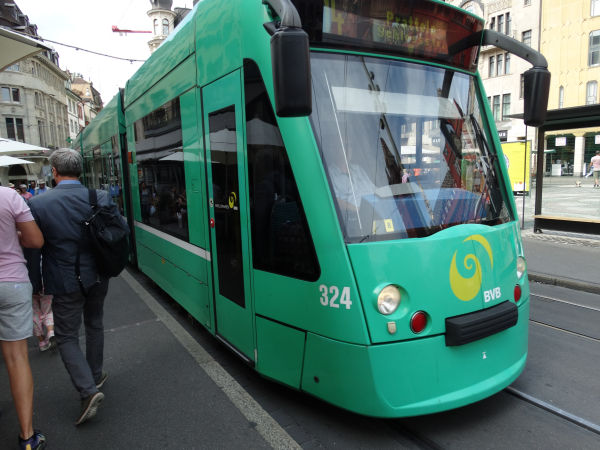
This is the front of one of Basel's Siemens Combinos before total renovation and rebuilding...
Picture from Basel Marktplatz 12.7.2019 by Ilkka Siissalo.
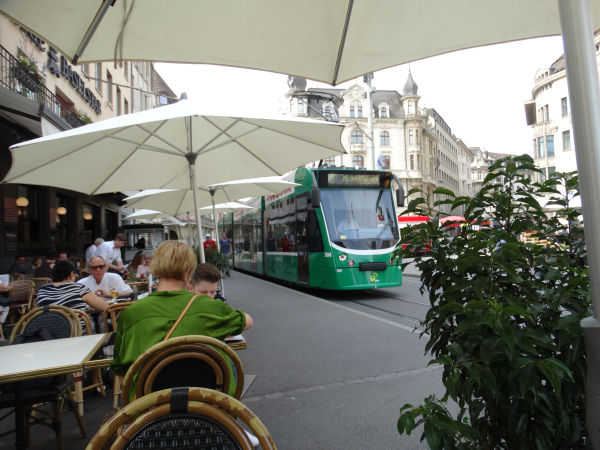
...and this is another, similar Combino but after a thorough modernisation, strengthening of its roof structures etc. Even the windscreen,
the painting scheme etc. is different now and the green colour used is again darker like in the old trams.
Picture from Basel Marktplatz 12.7.2019 by Ilkka Siissalo.
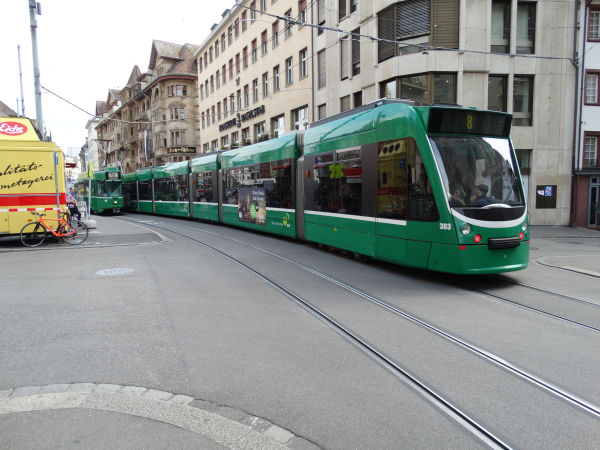
Here is another, totally rebuilt Combino. The key problem was that the very long trams were all the time operating in the old town with tight S-shaped
curves and the torsion forces resulting from these bends were much stronger than calculated. The way the roof and the walls were fixed together developed
cracks so that finally there was a risk that some of the heavy machinery on the roof could fall on the passengers. First this was circumvented by frequent
inspections and replacement of any cracked parts, but since 2004 Siemens recalled all the wagons one by one to a thorough rehaul and rebuilding.
Picture from Basel Marktplatz 12.7.2019 by Ilkka Siissalo.
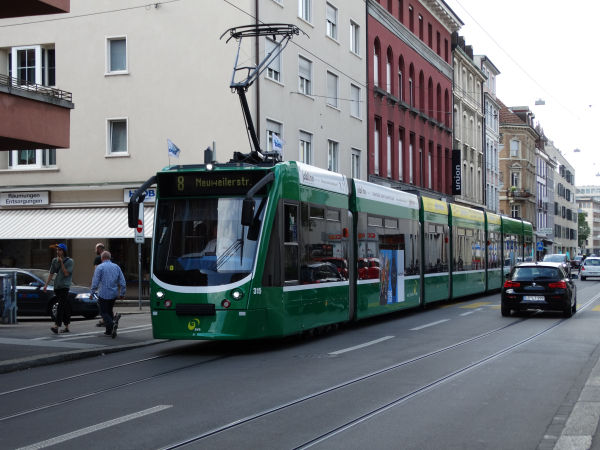
A totally rebuilt Combino tram on Klybeckstrasse in Kleinbasel.
Picture 12.7.2019 by Ilkka Siissalo.
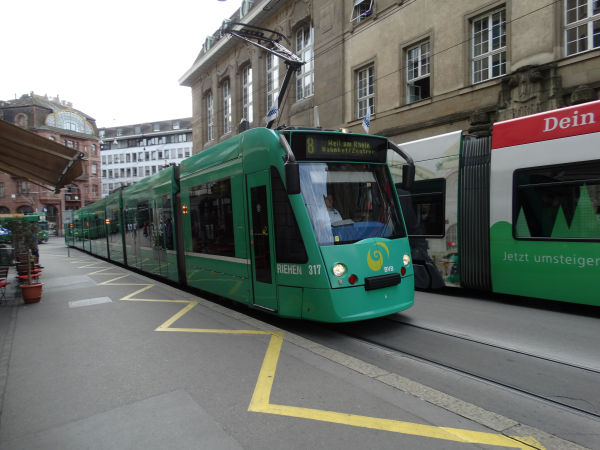
The Combino no.317 named Riehen after the Basel village where line 6 has its turning loop, is still one of those Combinos which has not yet been
totally rebuilt.
Picture from Basel Marktplatz 12.7.2019 by Ilkka Siissalo.
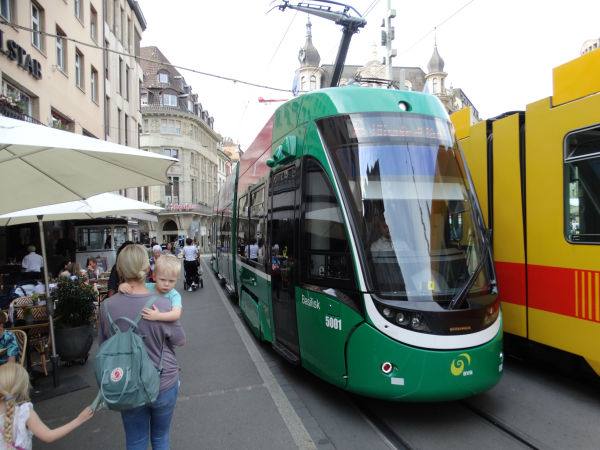
The experiences with Siemens' trams were so lousy that next time when BVB wanted to renew its fleet, it made an agreement with Bombardier.
Bombardier delivered a series of new low-floor trams nicknamed "Basilisk" and numbered in the 5000- series. They are of the type Flexity 2 and
Basel has agreed to buy up to 60 of them. This one, no.5001 is the very first new Bombardier Flexity 2 of Basel. Basel has now both five and
seven sections long versions of these new trams.
Picture from Basel Marktplatz 12.7.2019 by Ilkka Siissalo.
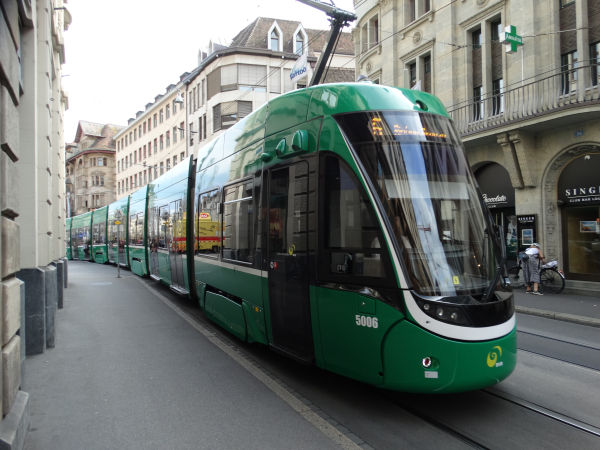
The seven sections long Bombardier Flexity 2 tram is a reeeeaaallllyyy long tram !
Picture from between the tramstops of Basel Marktplatz and Schifflände 12.7.2019 by Ilkka Siissalo.
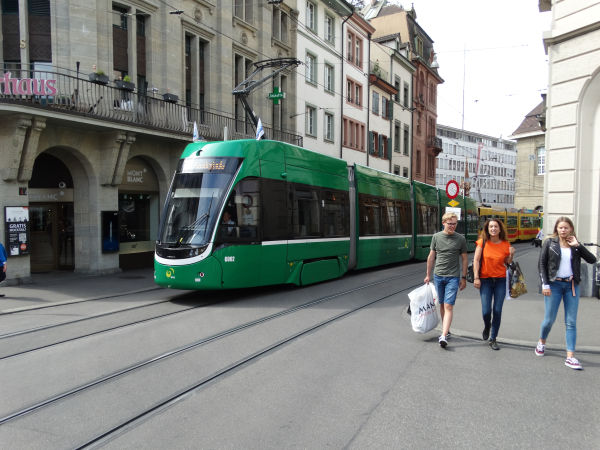
Even the five sections long variants of the same Flexity 2 tram are quite long, but not nearly as long as the seven sections long versions.
Five-section trams are numbered in the 6000- series, seven-section trams in the 5000- series.
Picture from between the tramstops of Basel Marktplatz and Schifflände 12.7.2019 by Ilkka Siissalo.
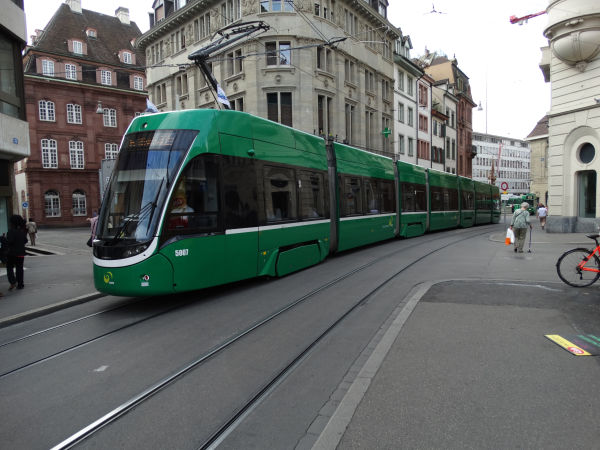
A seven sections long Flexity 2 tram numbered 5007 is approaching the tramstop Marktplatz.
Picture from between the tramstops of Basel Marktplatz and Schifflände 12.7.2019 by Ilkka Siissalo.
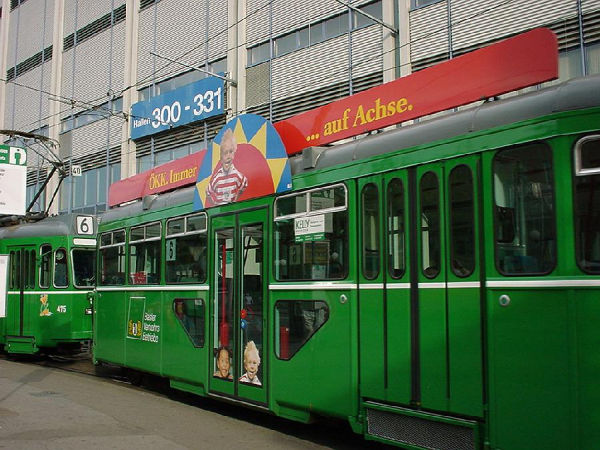
One way of modernising - or spoiling - old trams: the Basel BVB modernised almost all of its 1950s/ 1960s
trailer carriages by making the central part of the wagon low floor and adding in this new
"low floor department" a non-matching pair of modern doors which open outwards, creating a
funny looking contrast with the old pair of doors still left only offset by about a meter.
These "modernised" trailer coaches are mainly used in three coach combinations as the middle
coach, as here no. 1481 as a middle coach on line 6. In the background old, but now also
modernised motor wagon 475, now used as a second trailer. The picture is from 1999 but similar combinations could sometimes be seen in Basel even in
2019, with the addition that now there would be an additional air conditioner added to the roof of the old, poor trailer coach. Like a lump on a
camel's back.
Photo from 5.6.1999 taken by the Basel Messeplatz by Ilkka Siissalo.
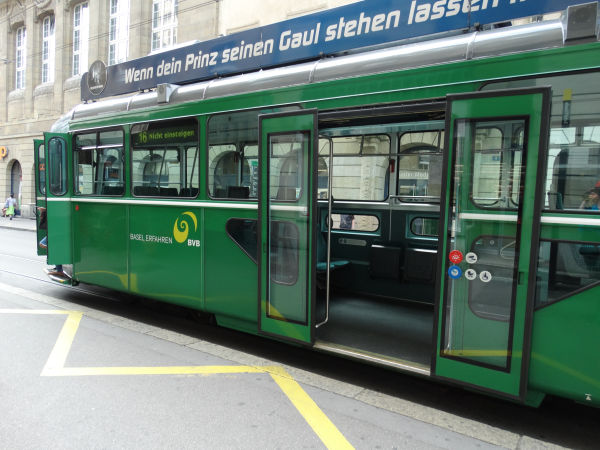
Look what they have done to the poor old, stylish 1950s trailer wagon :-( They've cut a big hole in the middle, thrown most of the seats away,
added those awful doors and added on top of the roof a vanload of machinery so that they can claim that at least some part of their tram-train
is now airconditioned and reachable for the ones who can't climb stairs. Rude, isn't it?!! To see how these trailers looked like before they were
spoiled, see below.
Picture of a "modernised" old trailer wagon 12.7.2019 at Marktplatz by Ilkka Siissalo.
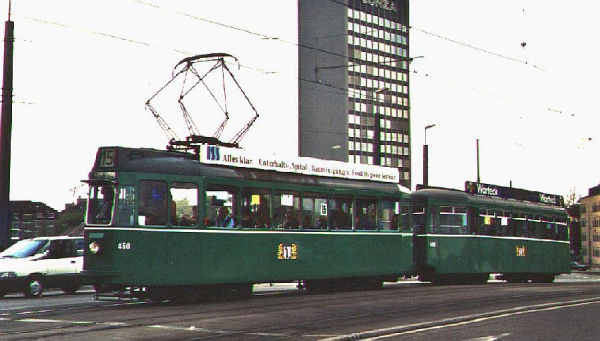
A Basel BVB 400 series classical tram from the 1940s to 1960s, a so called Swiss universal tram no. 450 together with its trailer coach
no. 1411 on line 15 at Grosspeterstrasse on their way towards Bruderholz. This shows them
in their original form as a first series tram - the BVB has lately very crudely "modernised" most of these old wagons,
lengthening their life span, but at the same time spoiling their look and feel. These very similar trams were once in use in Basel, Zürich,
Geneve, Bern - at least.
And by the way, note the difference in the shade of the green colour. Old Basel BVB trams were painted in a much darker green colour than the ones
which are new or are recently repainted.
Photo from Basel Grosspeterstrasse 24.5.1999 by Ilkka Siissalo. Scanned from a paper photo.
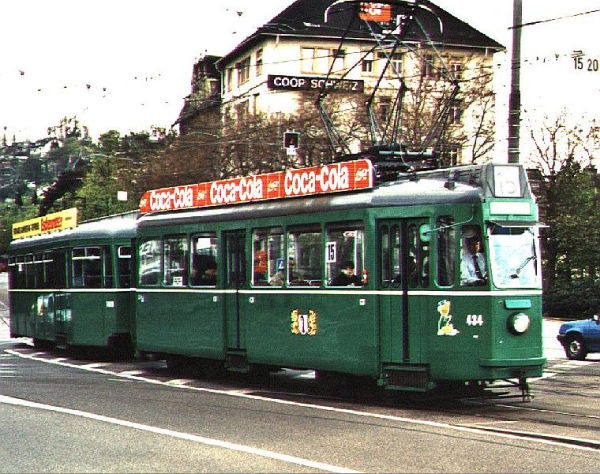
Basel BVB 400 series tram n.o 434 together with its trailer 1489 still in their original form, here
seen on line 15 near the tram station Münchensteinerstrasse, on their way to Mustermesse (Messe Basel). In their
old form the 400 series trams with their wooden benches and 1940s design were noisy, but with the old atmosphere. This was the type of tram which
according to the 1940s designers was to be the tram of the future for all Swiss cities.
Photo from Münchensteinerstrasse in Basel 24.5.1999 by Ilkka Siissalo.
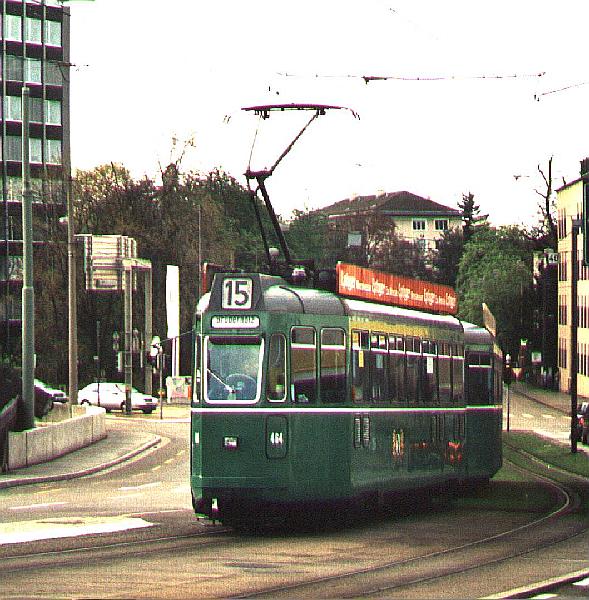
This was the last series of the so called universal Swiss trams. Compare with the one shown above, which is from the much older series.
Although they look very much the same as the older ones,
these were already inside quite modern trams with thyristor technology, built in the 1960s. After modernisation these newest Basel 400 series trams
have lost their old round headlights in favor of small modern rectangular halogens, they have a new, modern
"Einholm" style pantograph on the roof and several new ventilation openings have been
cut on the sides, along with holes for new axles. Benches are renewed as well, they are no more wooden as in the 1940s, and the trams as such are
capable of multiple coupling, allowing BVB to use them in combinations of 2 or more motor units. Still in 2019 BVB had some of these motor wagons
in use, but only as trailer wagons.
Photo of Be 4/4 no, 464 on line 15 by Wettsteinplatz in 24.5.1999 by Ilkka Siissalo.
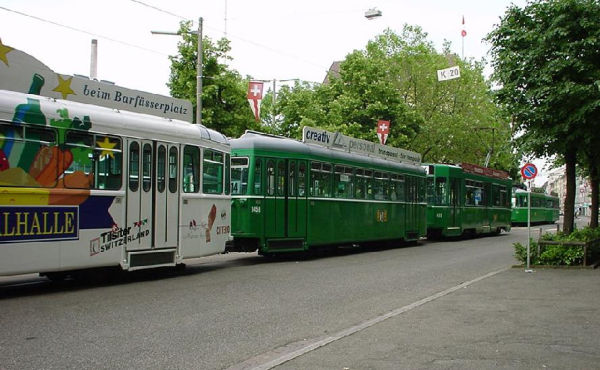
Towards the end of the 1990s it was possible to see three-coach trams on several routes in Basel and by then they could be
combined in several ways, for example motor-motor-trailer, motor-trailer-motor or motor-trailer-trailer. This is another view of
a Basel three coach tram combination, with motor wagon Be 4/4 no. 473 leading two trailer coaches of
the 1400 series, 1458 and an unidentified one, to the turnaround circle of line 14 at
Messeplatz, Kleinbasel. More and more of the trams were by then taped with full coach size
commercial ads, like the second trailer here. This kind of three wagon combinations with
only one motor wagon often had problems during slippery weather. Similar three coach combinations are sometimes in use still in
2019-2020, but then always in a motorwagon-trailer-motorwagon combination so that the unmotorised trailer in between is a modernised
old wagon with a low-floor door and air conditioning. The motorised wagons before and after the trailer may often be still
without air conditioning.
Photo of an unmodernised motorwagon-trailer-trailer combination by Messeplatz 5.6.1999 taken by Ilkka Siissalo.
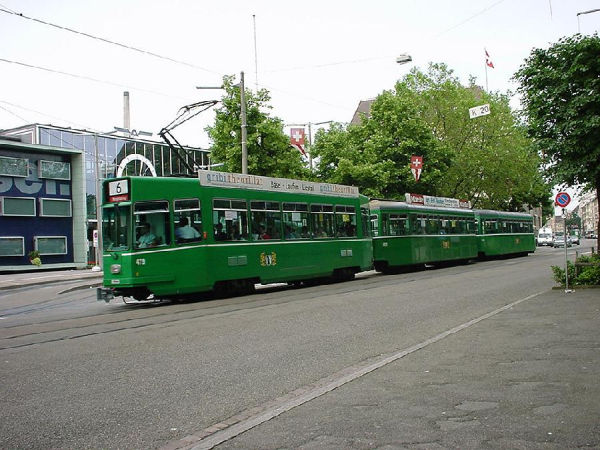
Three coach trams were typical of the long tram lines of Basel in late 1990s, either as motor wagon -
trailer - trailer combination, like here, or MW-MW-trailer, or MW-trailer-MW. Here tram Be 4/4 no.
479 leading two of the 1400 series trailers on line 6 arriving at Messeplatz in Kleinbasel. By 1999 almost all of the trams on
lines 6 and 3 were three-coaches long combinations with Be 4/4 motor wagons leading, either the thyristor driven Be 4/4s of the 1960s
or - most often - the more modern and broader Be 4/4 ones, nicknamed as "cornichons" (pickled small cucumbers). This motor wagon is one
of the newer "cornichons" and it has two of the trailers, both still totally unmodernised (a.k.a. "not yet spoiled").
Photo from Messeplatz 5.6.1999 by Ilkka Siissalo.
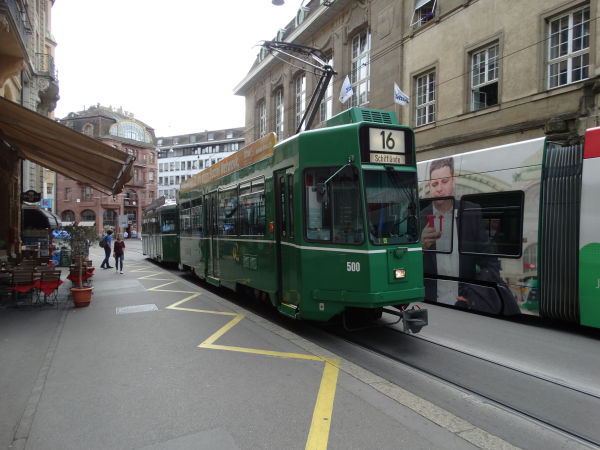
Even in 2019 two and three coaches long trams composed of non-articulated tram wagons were quite common, but then the leading motor wagon
would always be one of the 500 series Schindler tram motorwagons nicknamed cornichons. The trailers would either always be modernised
1950s style trailer coaches which now have a low-floor section and a low-floor pair of doors in the middle. In case of a three coaches long
tram-train, the last wagon would typically be one of the 1960s built last Swiss standard trams Be 4/4.
Picture of a two coach tram on line 16 with a "cornichon" leading 12.7.2019 by Ilkka Siissalo.
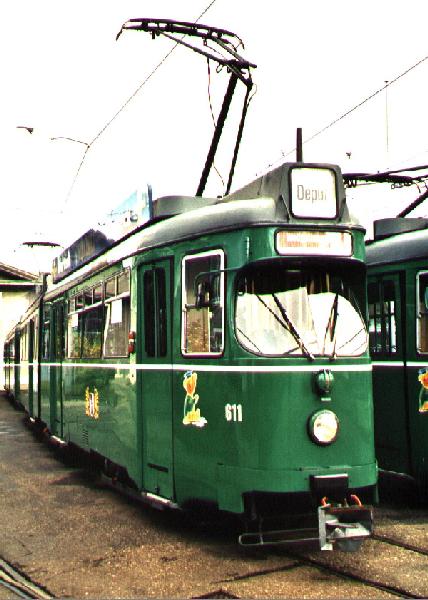
Series 600 BVB trams of Basel were typical articulated trams of the 1960s. They were most
often used (except on line 1) as pairs, which creates a really long vehicle combination. They were licence-built copies of German Düwag trams,
fairly (but not quite) similar to the trams used for example in Wien (Vienna). In the late 1990s they could usually only be seen on lines 1,3
and 14 and occasionally on extra tram services marked with just the letter E. By 2019 they have totally vanished from Basel already long ago.
Here no. 611 with no. 615 as its trailer wagon at the Wolfgottesacker depot. This combination had been on line 3.
Photo from Wolfgottesacker depot 5.6.1999 by Ilkka Siissalo.
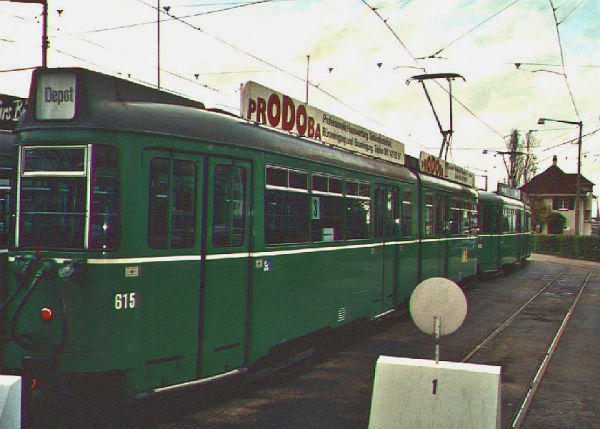
The same BVB 600 series tram combination of two series 600 trams seen from behind. The picture also shows how very long the typical operating
combinations of two such similar wagons were. They needed extremely long platforms at major stops, which was also a reason not to use them everywhere,
but they were for a long time used for example on the line no.1 which is a ring line around the city center with much traffic in and out at almost
all stops. Their disadvantages - no low-floor space, no airconditioning - finally led them to be abandoned.
Photo of numbers 615 and 611 at Wolfgottesacker depot 5.6.1999 by Ilkka Siissalo.
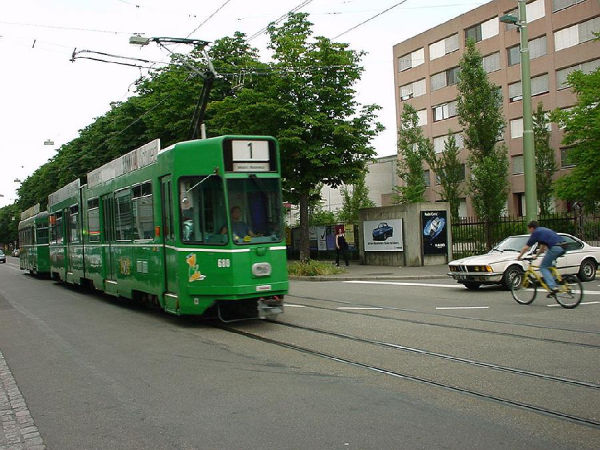
Combination of the 1970´s Basel BVB articulated tram no.680 with a 1950´s trailer coach,
both in their not-yet-modernised state, here in full speed on line 1 on Riehenring,
Kleinbasel. BVB modernised all of these 680 series articulated trams by adding a new low floor part
which elongated the tram by about 10 meters. The old trailers were also forcefully modified
as low floor coaches, by cutting a low floor section in the middle of the coach. However, the modification of these otherwise well working
trams by adding such a heavy middle section was not done properly. The middle pieces were very heavy and as they were low-floor, snow packed
under them and also blocked their doors. That modification was a spoilage of a working wagon. In 2019 the last ones of these trams can now be seen
in Oradea, where they were given as a gift, although the modernisation must have cost a lot. Like they were in this picture, they were still well
working, good Schindler trams, although they lacked a low-floor part and airconditioning.
Photo from Riehenring 1.6.1999 by Ilkka Siissalo.
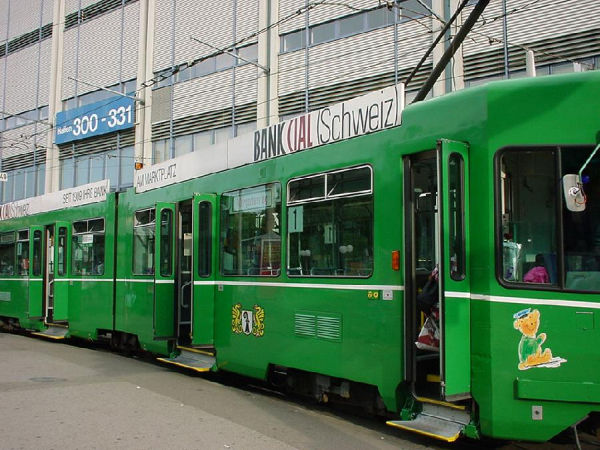
Another view of the BVB articulated tram no. 680, here at Messeplatz on line 1. Here, in the articulated joint in the middle of the tram, a 10 metres
long extra part was added. That was a big mistake, which spoiled a well working tram.
Photo 1.6.1999 by Ilkka Siissalo.
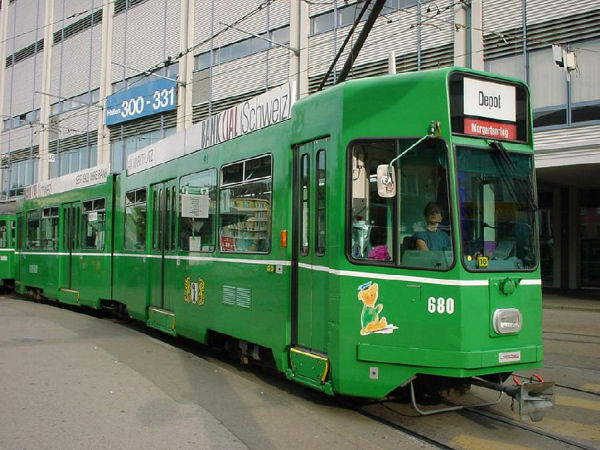
The BVB articulated tram no. 680 leaving Messeplatz on line 1.
Photo June 1st 1999 by Ilkka Siissalo.
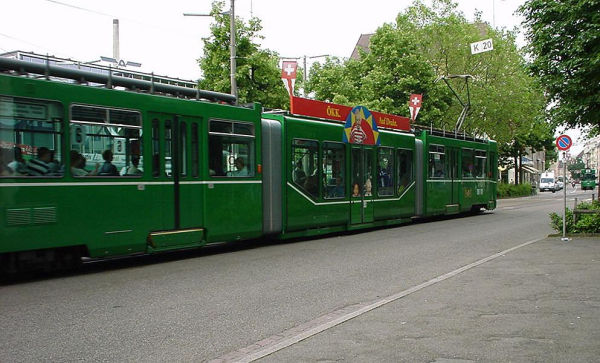
An example of how the Basel 680 series articulated trams of the 1970s looked like after BVB
had modernised them by adding a new low floor section in the middle of the tram. It "almost
fitted", but not quite, since the doors and other parts of the new section were of a much newer
style. To be quite frank, the new middle piece was ugly. And it also spoiled the tram as it came to its capabilities of
climbing hills and tolerating snow and slush. This kind of elongated trams still usually had in
the late 1990s a 1950´s style trailer coach behind them, creating a really long and a really odd-looking combination. A good tram was spoiled at high cost.
Photo 5.6.1999 on Clarastrasse by Ilkka Siissalo.
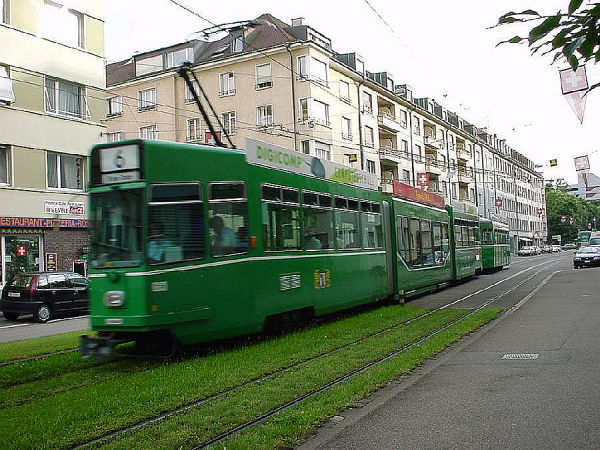
Tram combination of the new century ? Such were the hopes, but it was a failure. A Basel 1970´s 680 series tram which has gotten a 1990´s
brand new low floor segment in its middle in its "modernisation", with a 1950´s trailer coach behind, arriving
here at full speed to the Badische Bahnhof in Kleinbasel on line 6.
Photo 5.6.1999 by Ilkka Siissalo.

